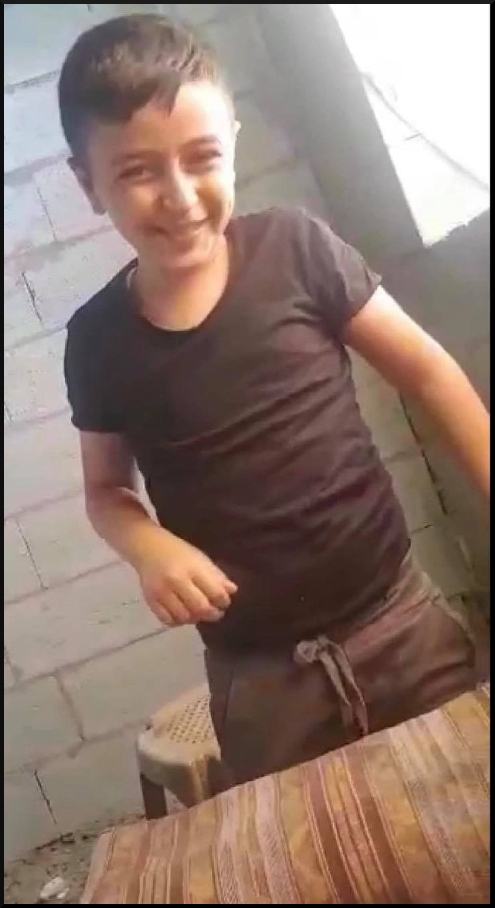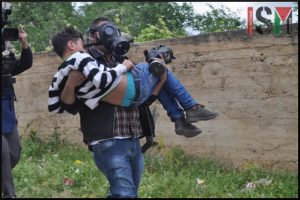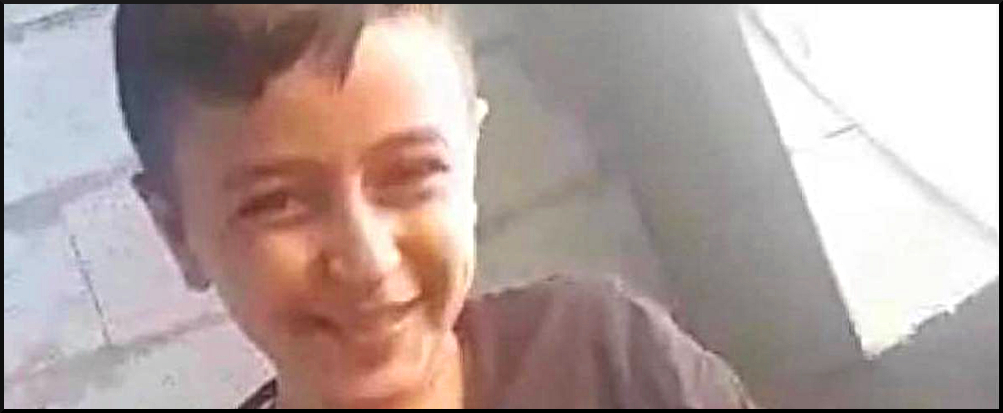by Yumna Patel, Published on Mondweiss, July 15, 2010
For eight years, the residents of the northern occupied West Bank village of Kafr Qaddum have protested every single Friday, rain or shine, against Israeli land confiscations and the closure of the village’s southern road by Israeli forces.
The villagers have faced their fair share of bullets, tear gas, injuries, and even death. But nothing could have prepared them for what happened on Friday, July 12, when Israeli snipers set their sights on 10-year-old Abdul Rahman Shteiwi.

It was a normal summer Friday in the village. Following the conclusion of the afternoon prayers, residents gathered in the sweltering heat and began their march, as they always did, from the town center towards the nearby Israeli settlement of Kedumim.
They carried posters and Palestinian flags, and chanted slogans demanding that the village’s road be opened.
“Our protests are always non-violent. We are armed only with signs and flags,” Murad Shteiwi, head of the popular resistance committee in Kafr Qaddum told Mondoweiss.
“At most, sometimes the young men throw stones in response to the soldiers, but that’s it. Never more than that.”
It wasn’t long, Shteiwi said, before the demonstration divulged into more violent confrontations, with Israeli forces firing tear gas, rubber bullets, and sound bombs into the crowd.
“But this Friday, they were using live ammunition, and they weren’t just firing it in the air. They were firing it at the people,” he told Mondoweiss, adding that there were Israeli snipers targeting people.
All of a sudden, the villagers saw Abdul Rahman fall to the ground, blood spilling from his head.
“He wasn’t even at the front of the clashes, there were tons of other young men in front of him. But they aimed at the child on purpose and shot him,” Shteiwi recounted.
After driving Abdul Rahman to the nearest hospital 20 kilometers away, Nablus’ Rafidia Surgical Hospital, he was rushed into surgery, where doctors spent three hours trying to control the bleeding and stabilize him.
Doctors told the boy’s family that he was shot with an expanding live bullet that exploded into more than 100 fragments after it lodged in his head, wreaking havoc on his brain and causing severe damage to three major blood vessels.
“The doctors told us that by the way he was shot, and the kind of bullet he was shot with, it is clear that the soldiers’ intention was to kill. Abdul Rahman was not supposed to live,” Shteiwi told Mondoweiss.
Middle East Eye quoted an Israeli army spokeswoman as saying that soldiers “used riot dispersal means” in the town, when questioned about the shooting of Abdul Rahman.
According to the International Solidarity Movement (ISM), whose activists were present on Friday’s protest, Israeli forces denied the use of live ammunition.
However, the group said in a statement that its activists
“found a 5.56 bullet case on the ground where protesters had been standing some 15 minutes before. The case was hot to the touch suggesting it had been fired that afternoon. Dozens more bullet cases were also found by villagers following the protest.”
Shteiwi insists that the shooting was intentional.
“The sniper was professional, he knew what he was doing. This could not have been an accident, or just crowd control as they say,” he told Mondoweiss.
‘Indescribable feeling’
Since his surgery, Abdul Rahman was transferred to the Tel HaShomer hospital in Tel Aviv, where he has remained in a coma. His father has remained by his side and has been giving updates to the town on his son’s condition.
Shteiwi, a relative of the family, says that the entire village has been in mourning since Friday, with shops shuttering their doors, and others canceling their weddings.
“Everyone is distraught,” Shteiwi said, adding that Abdul Rahman’s mother had just undergone open heart surgery two weeks before her son was shot. “Just since Friday, we have had to take her to the hospital three times because her health keeps deteriorating,” he said.

Shteiwi told Mondoweiss that he could not begin to describe the pain of Abdul Rahman’s parents, even though it is one he himself knows well.
“My own son was shot in the leg during protests once,” he said. “The pain of watching your son get shot in front of you, it is indescribable.”
A history of violent suppression
Ever since the villagers of Kafr Qaddum began their weekly marches in 2011, they have been met with violent suppression by Israeli forces.
In the first three years, between 2011-2014, Shteiwi says two residents were disabled for life after being badly injured by Israeli forces.
One man was shot in the mouth with a tear gas canister, fracturing the bones in his face and jaw to the point where he has been unable to speak since. Another, Shteiwi says, was shot in his eyes with a rubber bullet, blinding him.
In 2014, the village was shook when a 75-year-old man participating in the demonstration suffocated and died from tear gas inhalation. He was the first “martyr” from the village.
Before 2014, Shteiwi says that soldiers used rubber bullets and tear gas against protesters. But from 2014-2016, they began employing the widespread use of .22 caliber bullets, or “tutu bullets.”
The Israeli army had long classified .22 caliber rifles as crowd control weapons, but in 2001, they were banned by the Israel military advocate general as a means for crowd dispersal due to the fact that, while small, they can be lethal.
Shteiwi estimates that more than 85 people from Kafr Qaddum were injured with “tutu bullets” between 2014-2016, a large part of them children under the age of 18.
“After we put so much pressure on the Israelis through the media and the international community, after 2016 they stopped using the tutu bullets as much,” Shteiwi said.
But at the beginning of this year, the villagers noticed the soldiers’ method of “crowd control” take a deadly turn.
“They have started to use live bullets a lot more. Just in january, they shot five guys with live bullets. One kid was shot in the neck and was in critical condition,” Shteiwi said.
In general, he said, soldiers have been shooting live ammunition into the air above the crowds. But on Friday, they were aiming directly at the people.
Why are children at the protests?

Over the years, Shteiwi has been interviewed by countless foreign journalists in regards to the protests in Kafr Qaddum.
One of the most common questions he is asked, when the injury of a child is involved, is “why was the child participating in such activities” that are known to get violent?
Expressing his frustration over such questions, which he says play into the hands of the Israeli occupation, Shteiwi told Mondoweiss:
“When people ask why kids are participating, its because they are protesting what they see, what they experience every day under occupation. They feel that they are in a jail, and don’t have basic rights to live. They see that every day, so why wouldn’t they protest?”
“Our message to the international community, is when things like this happen, don’t ask why kids are in the protests, and blame us for what happens to our kids,” he continued.
“Ask instead, what are the circumstances that are forcing children to go protest in the first place? That is where you will find your answer.
